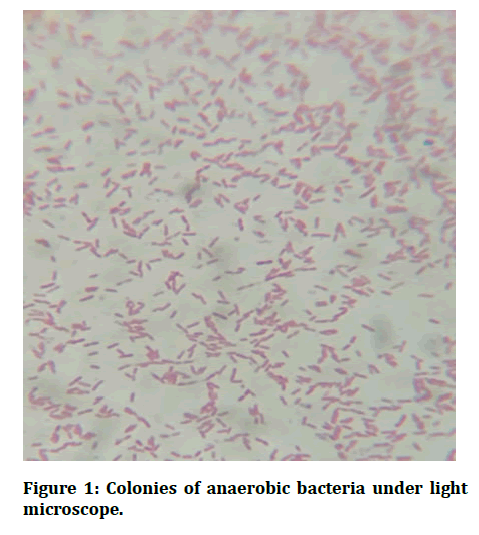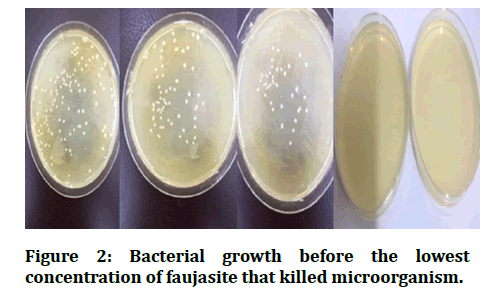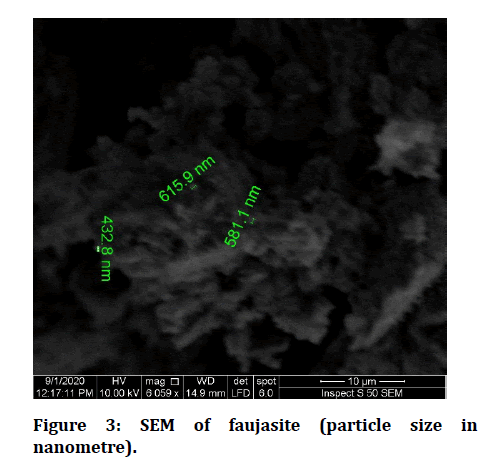Research - (2021) Volume 9, Issue 9
Assessment of Anti-Bacterial Effect of Faujasite from Patients with Periimplantitis
Ahmed Ali Mohammed1* and Thekra Ismail Hamad2
*Correspondence: Specialized dentist, Al-Diwaniya Directo. Ahmed Ali Mohammed, Ministry of health Baghdad, Iraq, Email:
Abstract
Objective: To assess the concentration of Faujasite that inhibit growth of the anaerobic bacteria that growth around implants with signs and symptoms of implant failure. Design: Experimental in vitro study, antimicrobial effect of faujasite nanoparticles on the anaerobic bacteria isolated from patients with peri-implantitis. Material and methods: Ten partially edentulous subjects (six women, four men), aged 32– 90 years, who had one or more implants with peri-implantitis, a total of 15 implants were diagnosed with peri-implantitis. Samples of Subgingival bacterial were obtained with sterile paper points from infected implants of everyone. Results: Revealed that Minimum Inhibition Concentration of Faujasite nanoparticles for Total anaerobic bacteria was (3%), this concentration showed growth after re-culturing on plain BHI-A media. Discussion: Antibacterial property at 3% concentration of Faujasite nanoparticles, because of metallic contents such as aluminium ions were found in faujasite framework, which induced for better minimum inhibition concentration quantity, in addition the state of oxidation for the Si has an important property in the antimicrobial activity. Conclusion: The antibacterial activity increased with the increasing in the Faujasite concentration from 3% and above, and there was no effect of Faujasite nanoparticles at concentration1%, 2%, and 2.5%.
Keywords
Gaspack, Sabouraud dextrose agar, Oxiod
Introduction
Faujasite is one type of zeolite, so it is a porous aluminosilicate agent with pore size between 3 to 10 A in diameter. These pores can trap cations (Ag, Zn), water, and organic molecules and exchange them by other cations. By this way zeolite can display appealing features such as antimicrobial effect. Its main constituents are phosphorus, aluminium, oxygen, silicon, etc., which they are repeated in the structure. Zeolites are divided into synthetic and natural groups. Zeolites are widely used in various sciences. Faujasite has been used in industry, agriculture, Animal feed and poultry, Water pollution treatment, biochemistry and so on. Recently it was taken into consideration in medicine. They are widely used in medicine such as wound dressing, drug delivery, as an antibacterial agent, anticancer agent, for osteoporosis treatment, treatment of various diseases, tissue engineering and so on. Zeolite has been also used in dentistry especially for antibacterial properties [1]. Microbial colonization and antibacterial movement on metallic and ceramic implanted materials have been accounted for under in vitro and in vivo tests. Titanium itself has no antibacterial movement, however there is a plausible danger of plaque development on titanium inserts. In any case, hardly any investigations have been led on a superficial level alteration of titanium inserts to repress the colonization of oral microbes [2].
Materials and Methods
Preparation of culture media
Brain heart infusion agar (BHI.A)
The readiness of this media was by the guidance of Oxoid Laboratories Company by suspending 47 gm of powder in 1000 ml refined water at that point blended well utilizing attractive stirrer to guarantee disintegration of the entire amount of the powder.
The media was sanitized by the maker's headings. To sanitized media can be used autoclave at 121áµ?C for fifteen minutes after it was poured in sanitized petri dishes, then put aside to cool until use [3].
Brain heart infusion–blood agar (BHIB.A)
Arrangement of this media was by the guidance of Oxoid Company. After cleansing, this media allowed to cool at 45áµ?C and afterward add 5-7% ml of blood and the media was poured in sterilized petri dishes to cool at room temperature, set and were then put away in the fridge until use [4].
Prepared of brain heart infusion broth BHI.B
According to manufacture, the media was prepared by using 34.5 gm of it, dispersed in one thousand ml of distilled water, and locked with caped bottles. Cleansing was finished via autoclave at 15 Ibs pressure, 121°C for 15 minutes [5].
Prepare of muller Hinton agar
By Follow the instruction of producer, it was used 35 of agar powder in 1 liter of water refining until total powder of agar was disintegration to sanitize it by autoclave [6].
Method of sterilization
Sterilization was done via autoclave at 121 áµ?C and pressing factor of 15 pounds/inch2 for 15 minutes included media, water, and Phosphate buffer solution (PBS) but mouth reflect, kidney dishes, and all spotless glasses were managed by dry air broiler at 180 Cº for 60 minutes. Chairs and floor of the lab were sanitized by Dettol clean arrangement [7].
Sample and culture
Anaerobic microbes were secluded from the mouth of 10 patients in the school of dentistry with indications of embed disappointment and bone loss. Anaerobic microorganisms were obtained from the mouth by a swab [8]. This procedure incorporates a delicate scouring of pockets around 11 mm by a sterile q-tip, and afterward along these lines immunizing an essential separation medium, for example, Sabouraud dextrose agar (SDA) [9]. At 37°C for 24 - 48 hrs., swabs were purified on Sabouraud dextrose agar and brooded forcefully, then at 4°C was stored for extra investigation [10].
Culture and analysis of microbes
In glass universal tubes containing 5 ml of Phosphate buffer solution, the sample of anaerobic bacteria mixed in vortex for 2-3 minutes, bacteria were taken by sterile loop and trace it, then incubated for 96 hrs. in blood agar. At 37áµ?C, also plan tubes containing 10 millilitres of BHI broth were inoculated and incubated for 48 hrs. At 37áµ?C All plats and tubes were used gas pack to incubate it in anaerobic condition.
Maintenance of bacterial isolate
States from bacterial confines were gotten from the bacterial agar media and moved to 10 ml of sterile BHI stock and hatched in anaerobic for 24 hrs. at 37áµ?C. These supplies were put away in cooler until utilized and this methodology was repeated twice a month to month [11].
Activation of isolated anaerobic microorganisms
By the expansion of clear, disconnects to ten millilitres of sterile BHI stock which were brooded vigorously for 24 hours, at 37áµ?C and anaerobically for anaerobic microscopic organisms, Inoculums of bacterial were done [12].
Determination of viable count
Absolute reasonable check CFU/ml were finished utilizing sequential weakening with PBS and 0,1 ml from 10-3 – 10-5 were vaccinated on BHI.A brooded anaerobically for 24 hrs. at 37áµ?C [13].
Gram's stain
In the sterilization condition, Gram's stain was put to the distraction parts of blood agar. A little inoculum from a disconnected province was taken, emulsified in a drop of typical saline on a glass slide to frame a suspension, spread, dried and heat fixed. Gram's staining performed beginning with violet for 1 moment and afterward washed with water, stained with Iodine then, cleaned, removed color with ethanol liquid for half an hour. Counter stained with safranin for an extra a moment, washed and dried. Under a light magnifying lens with 100X amplifier, the slides were analysed for staining properties, cells' morphology, and course of action as shown in Figure 1 [14].
Figure 1: Colonies of anaerobic bacteria under light microscope.
Calculate the activity of nanoparticles Faujasite against anaerobic bacteria
In this study, the antimicrobial effect of the Faujasite NPs on total anaerobic bacteria was defined by the agar diffusion method using ten numbers of isolated anerobic bacteria.
Procedure
Muller Hinton agar media was put about twenty-five millilitres in separated partition of the sterile Petri dishes and waited until set. Brooded at 37â?¦C for 24hrs. to ensure the media was sterilized. There was activated about 0.1 ml of all-out anaerobic (dilution 10-1) cell forming unit/ml confine was spread on MH agar plates and left for twenty minutes at room temperature, at that point wells of equivalent size and profundity made with clean hardened steel Cork drill in the MH agar 6mm in breadth were set up in the agar. Three holes in each plate, each one was loaded very well up with Faujasite Nanoparticles in various fixations concentration of 3,7,10%. Plates left in the room temperature for 10 minutes, and subsequentially brooded in an in an anaerobic container with a gas pack for 24hrs at 37áµ?C. Restraint zones were across the breadth of each hole. The breadth of restraint around the wells containing the test materials was estimated and recorded after the hatching under aseptic conditions. By the Vernia caliper can be measured the area of inhibition zone.
Determination of minimum inhibition concentration (MIC) for anaerobic bacteria
All the selected concentrations dispersed separately with BHI-A to obtained 25 millilitres of agar after pouring it in suitable Petri dishes to become hard, then brooded with 0.1 millilitre of anaerobic bacteria which was activated separately. At 37°C including the control plates (negative control which contained BHI-A with microbial inoculums without the addition of the Faujasite nanoparticles and the plates which contained BHI-A and different concentrations of the Faujasite Nanoparticles without microbial inoculums) which were incubated for one day. Examination all the prepared Petri dish to notice growth of bacteria. The lowest concentration killed the microorganisms could be consider minimum inhibition concentration as seen in Figure 2.
Figure 2: Bacterial growth before the lowest concentration of faujasite that killed microorganism.
Results and Discussion
Antibacterial activity of Faujasite nanoparticles on microorganisms (agar well diffusion method). Results revealed that Minimum Inhibition Concentration of Faujasite nanoparticles for Total anaerobic bacteria was (3%), this concentration showed growth after reculturing on plain BHI–A media (there was no effect of Faujasite nanoparticles at concentration 2%, 2.5%) number of isolates within the MIC and the concentrations of the Faujasite nanoparticles as shown in Table 1.
Table 1: Total viable of anaerobic bacteria.
| Concentration of faujasite | Total viable of bacteria |
|---|---|
| 1% | growth |
| 2% | growth |
| 3% | No growth |
| 4% | No growth |
| 5% | No growth |
| 6% | No growth |
| 7% | No growth |
| 8% | No growth |
| 9% | No growth |
| 10% | No growth |
The suitable tally of anaerobic bacteria (CFU/ml) an aggregate of 10 segregates were analysed all examples were weakened 1:10 in ordinary saline (0.9% NaCl). Sequential weakening (10-1 to 10-5) were made in ordinary saline and 100μl were plated on blood agar. The plates were hatched at 37áµ?C for 72 hrs., utilizing gas pack. Various delusion were considered and detailed settlement framing units/ml (CFU/ml).
Mean of MIC for 10 samples of each 3, 7, and 10 % of Faujasite was 15.9,21, and 25 in sequential as shown in Table 2.
Table 2: The minimum inhibition zone.
| Inhibition zone | 3 % of faujasite | 7% of faujasite | 10% of faujasite | |
| Sample 1 | 15 mm | 21 mm | 25 mm | |
| Sample 2 | 17 mm | 23 mm | 23 mm | |
| Sample 3 | 16 mm | 23 mm | 22 mm | |
| Sample 4 | 14 mm | 20 mm | 27 mm | |
| Sample 5 | 14 mm | 21 mm | 26 mm | |
| Sample 6 | 16 mm | 21 mm | 27 mm | |
| Sample 7 | 18 mm | 18 mm | 25 mm | |
| Sample 8 | 18 mm | 19 mm | 25 mm | |
| Sample 9 | 15 mm | 22 mm | 25 mm | |
| Sample 10 | 16 mm | 22 mm | 25 mm | |
| Mean | 15.9 | 21 | 25 | |
| S.D. | 1.4 | 1.58 | 1.56 |
According to manufactured information Faujasite has antimicrobial properties. FAU zeolite has classified into two types- Y and X - depending on the Si/Al percentage: Y (Si/Al 2.5) and X (Si/Al 1.5) were suitable for multiple usage to build the proficiency of ionic trade [15]. The morphology and molecule size of the examples were explored utilizing SEM portrayal, as demonstrated in Figure 3. From the picture, the morphology of the FAU powder doesn't show a reasonable molecule shape which demonstrates the indistinct idea of the example [15].
Figure 3: SEM of faujasite (particle size in nanometre).
A particle shape was noticed in the specimen with 432.8-615.9 nm., the average particle size was noticed in 243.9 nm that explained in many old surveys.
Average particle size was showed about 432.1 nm in this survey. All specimens were noticed broad T–O (T=Si or Al) in the wavenumber’s area of 900–1100 cm−1 which was interpreted an amorphous crystal faujasite characteristic.
Examines was acted in faujasite focuses indicated great antimicrobial action, especially against anaerobic microscopic organisms [16]. In the concentration of 1, 1.5, 2 and 2.5 % of faujasite, there were not detected any antibacterial property to these concentrations but at 3% concentration, The MIC became clearly, so these results were occurred because of metallic contents, in addition aluminium ions were found in faujasite framework [17] which induced for better MIC quantity.
The state of oxidation for the Si has an important property in the antimicrobial activity as shown in previous studies, but this study was used ranging from 3% to 10% of faujasite, so the antimicrobial capability of zeolite as well as its MIC quantity were evaluated in tested microbial strain. Agar dilution method was utilized to evaluate the antibacterial property of faujasite by using indicator strains [18].
Faujasite is aluminosilicates with a uniform microporous structure, researchers have demonstrated zeolites to be non-poisonous, feasible transporters, controlled delivery specialists, and adjuvants for drugs. High-silica Faujasite might be saved on microbes, accordingly, killing the arrival of hurtful particles along these lines, it is the impact on the movement of bacterial by the damage of the living framework or the impact on the external layer of the cell by particle trade with the faujasite through the pores that present in the system of the design [19]. The property of Faujasite basicity was occurred due to found of the aluminate anion (AlO4) in their framework. Fundamental locales are related with the oxygen ions near the cations that make for the negative charge [20].
Conclusion
The lower MIC value was recorded at 3% of Faujasite. The potential of activity antimicrobial was associated to its contents include ions of aluminium, Na, Mg, and ions exchange in the framework of faujasite. The ion exchanged in synthetic faujasite structure has a significant role for the anaerobic bacteria inhibition. Antibacterial activity increased with the increasing in the Faujasite concentration from 3% and above, and there was no effect of Faujasite nanoparticles at concentration 1%, 2%, and 2.5%, so MIC of Faujasite nanoparticles that obtained antibacterial properties was 3% of faujasite in concentration.
References
- Safari F, Houshmand B, Nejad AE. Application of zeolite, a biomaterial agent, in dental science: A review article. Regeneration Reconstruction Restoration 2020; 3:10.
- Ferraris S, Spriano SJ. Antibacterial titanium surfaces for medical implants. Materials Sci Eng 2016; 61:965-78.
- Kumar HS, Parvathi A, Karunasagar I, et al. Prevalence and antibiotic resistance of Escherichia coli in tropical seafood. World J Microbiol Biotechnol 2005; 21:619–623.
- Zimbro MJ, Power DA, Miller SM, et al. Johnson. Difco & BBL manual of microbiological culture media second edition. 2nd Edn. 2009.
- Li XZ. Atlas of oral microbiology from healthy microflora to disease. Elsevier 2015.
- https://microbiologyonline.org/file/fa3f7a18b16eef6c8eb80069a17c4bcc.pdf
- Ali AK, Basima GH, Abbas S. Potential effect of 2% chlorhexidine gel in the implant screw hole on bacterial count. Int J Med Res Health Sci 2017; 6:125-32.
- Marsh PD, Devine DA. How is the development of dental biofilms influenced by the host? J Clin Periodont John Wiley & Sons, Ltd 2011; 28–35.
- Reibel J. Prognosis of oral pre-malignant lesions: Significance of clinical, histopathological, and molecular biological characteristics. Critical Rev Oral Biol Med 2003; 14:47–62.
- Byadarahally Raju S, Rajappa S. Isolation and Identification of Candida from the oral cavity. ISRN Dent 2011; 2011:1–7.
- Hadi SA, Al-Mizraqchi AS. Antibacterial activity of zinc oxide nanoparticles on the growth of enterococcus feacales, candida and total root canal microbiota (In vitro study). Indian J Public Heal Res Dev 2019; 10:2134–2139.
- Belay N, Rasooly A. Staphylococcus aureus growth and enterotoxin a production in an anaerobic environment. J Food Prot 2002; 65:199–204.
- Haenle M, Zietz C, Lindner T, et al. A model of implant-associated infection in the tibial metaphysis of rats. Sci World J 2013; 2013.
- Beveridge TJ. Use of the gram stain in microbiology. Biotech Histochem 2001; 76:111–8.
- Osatiashtiani A, Puértolas B, Oliveira CCS, et al. On the influence of Si: Al ratio and hierarchical porosity of FAU zeolites in solid acid catalysed esterification pretreatment of bio-oil. Biomass Convers Biorefinery 2017; 7:331–342.
- Ferreira L, Fonseca AM, Botelho G, et al. Antimicrobial activity of faujasite zeolites doped with silver. Microporous Mesoporous Mater 2012; 160:126–32.
- Deng C, Zhang J, Dong L, et al. The effect of positioning cations on acidity and stability of the framework structure of y zeolite. Sci Rep 2016; 6:1–13.
- Dutta P, Wang B. Zeolite-supported silver as antimicrobial agents. Coordination Chemistry Rev 2019; 383:1–29.
- Buchwald Z, Sandomierski M, Voelkel A. Calcium-rich 13X zeolite as a filler with remineralizing potential for dental composites. ACS Biomater Sci Eng 2020; 6:3843–354.
- Almeida KA, Hammer P, Cardoso D. Faujasites exchanged with alkylammonium cations applied to basic catalysis. Microporous Mesoporous Mater 2019; 282:159–68.
Author Info
Ahmed Ali Mohammed1* and Thekra Ismail Hamad2
1Ministry of health Baghdad, Iraq2Department of prosthodontic, College of dentistry, University of Baghdad, Bagdad, Iraq
Citation: Ahmed Ali Mohammed, Thekra Ismail Hamad,Assessment of Anti-Bacterial Effect of Faujasite from Patients with Periimplantitis, J Res Med Dent Sci, 2021, 9(9): 166-170
Received: 25-Jul-2021 Accepted: 13-Sep-2021



